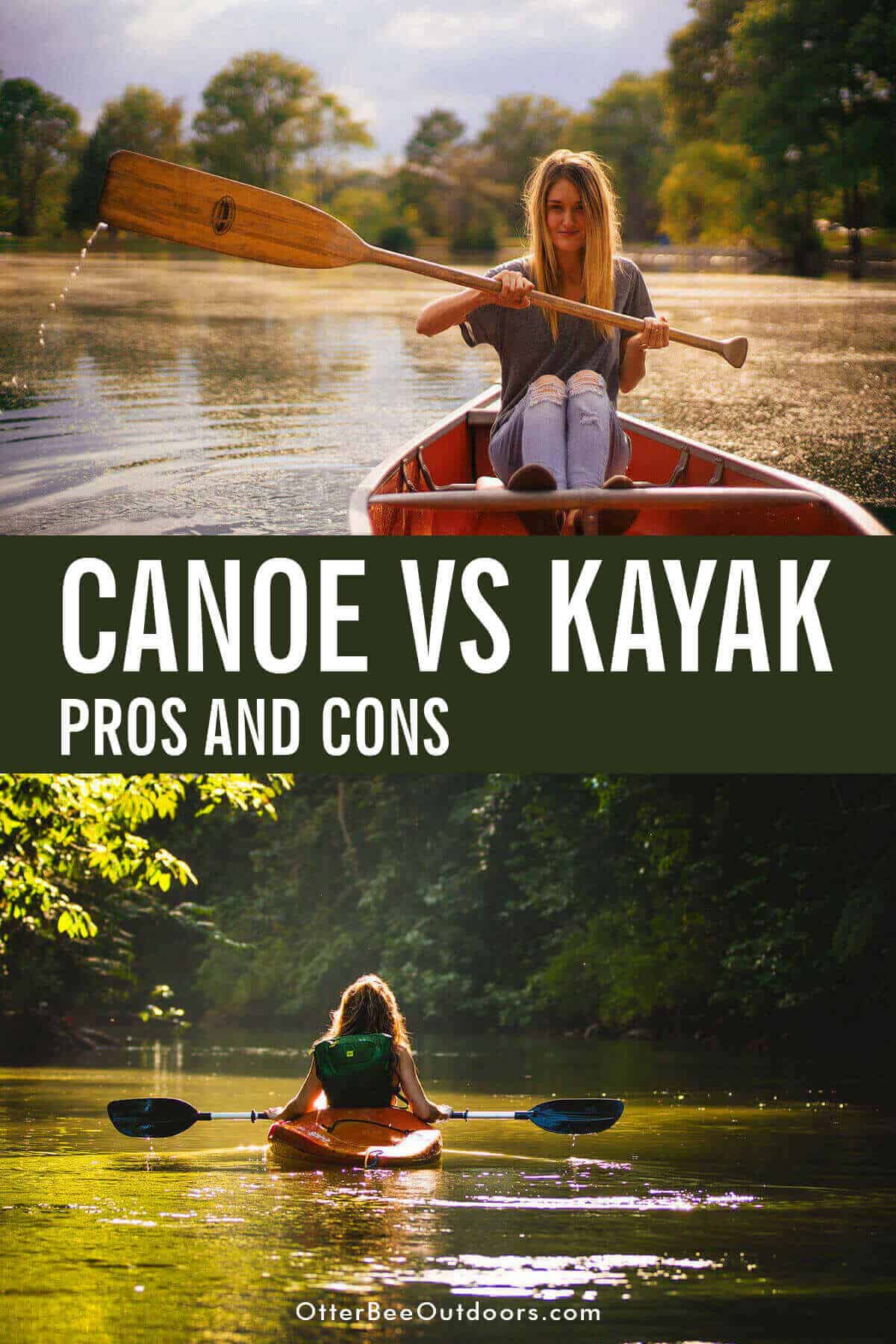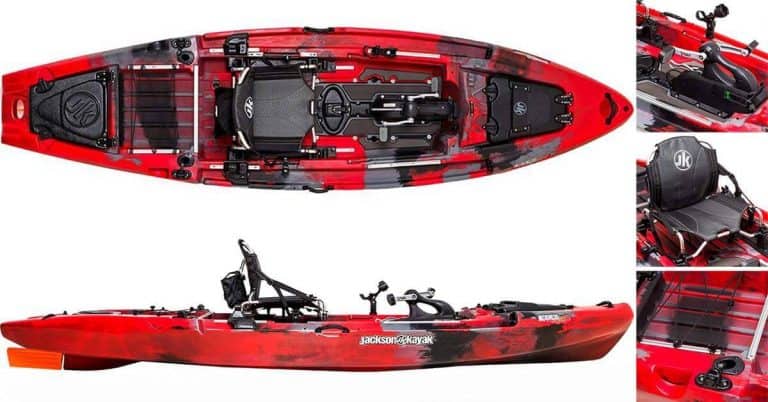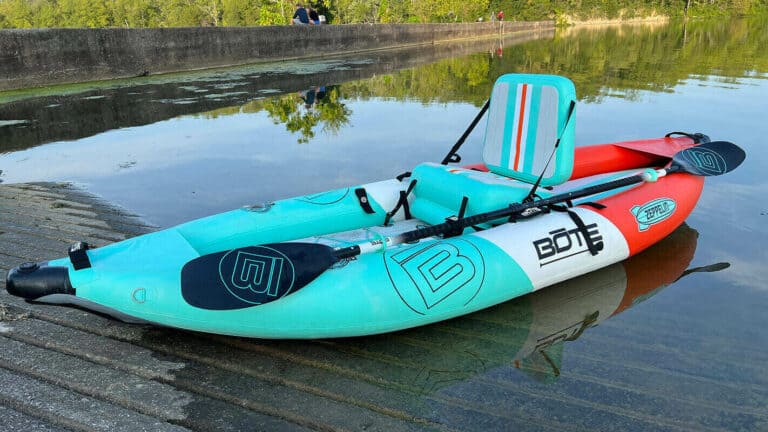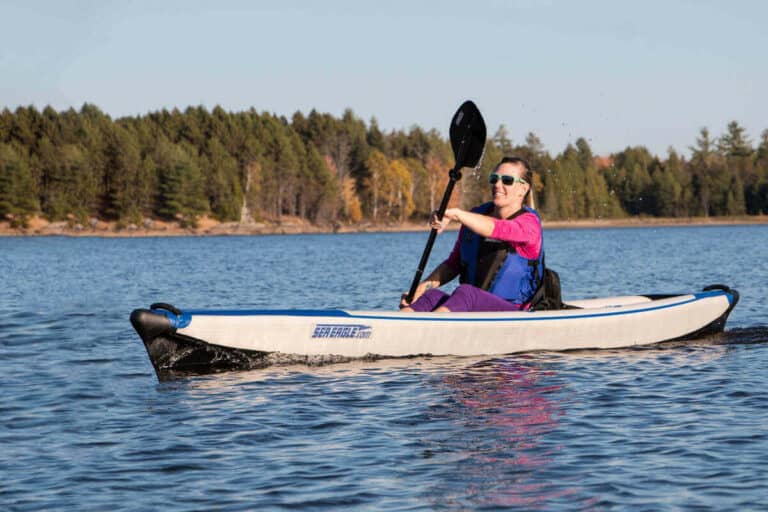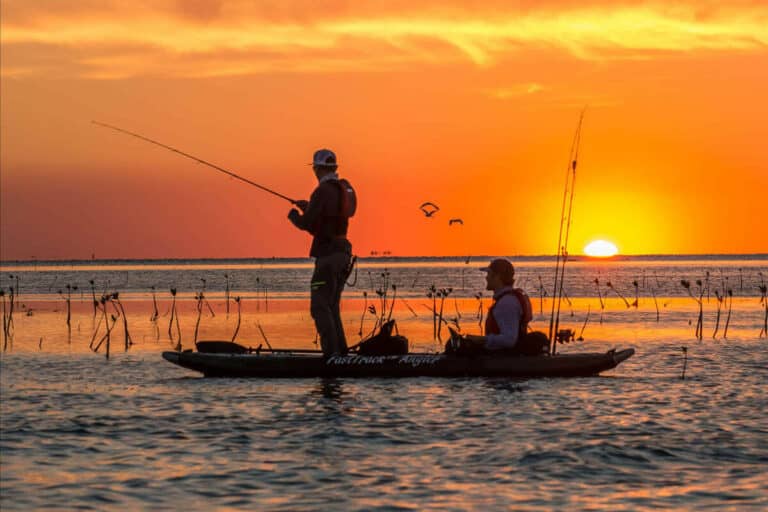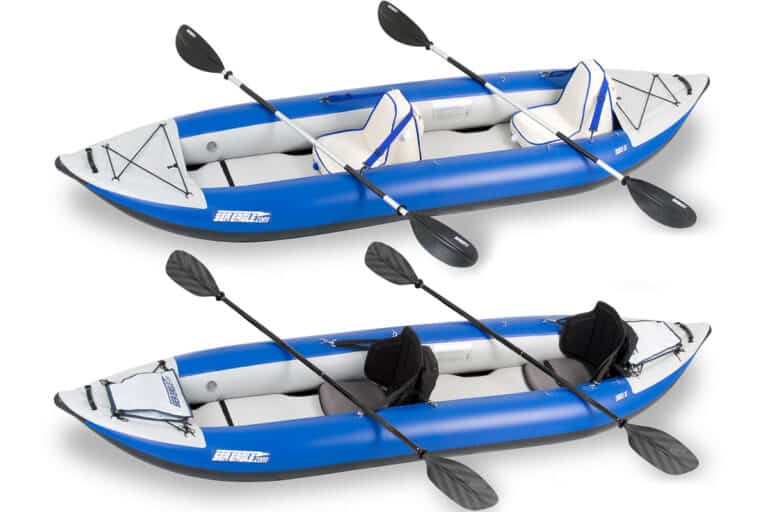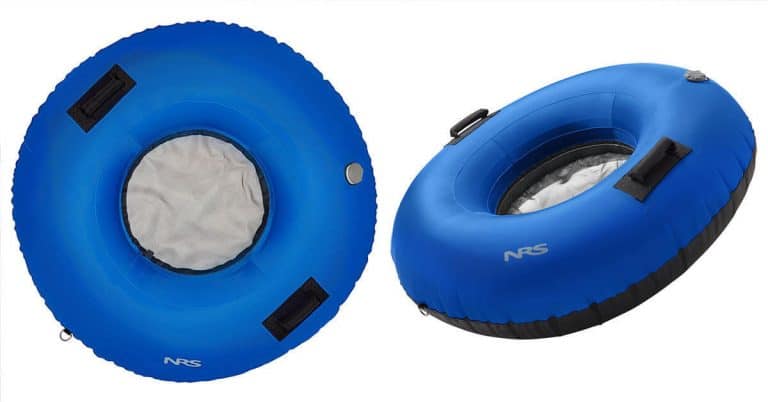Disclosure: I am compensated for purchases made through some links on this site. Click for details.
When it comes to outdoor activities such as paddling, fishing, and camping – one of the biggest questions is: canoe vs kayak? Which type of boat should you choose for your next adventure?
From design differences and paddling techniques to performance capabilities, there are many aspects to consider when deciding between these two classic vessels.
To help navigate this decision process we will discuss all things kayak versus canoe including the advantages and disadvantages of each option as well as how best to choose which vessel suits your needs most effectively.
We’ll also discuss their various uses as well as safety considerations when paddling either option. Finally, we will cover maintenance tips for owning a canoe or kayak so that it lasts longer.
Whether you’re looking for an adventure on the water or just want to relax in nature’s beauty, I’ll provide all the information needed before deciding whether a canoe or kayak fits your style better.
So let’s dive into the great canoe vs kayak debate.
Canoe vs Kayak: Overview

Canoes and kayaks are two of the most popular watercraft used for recreational activities. While they may have some similarities, there are some key differences between them that make each type of boat better suited to different types of activities.
Definition of Canoe and Kayak:
A canoe is a narrow, open-topped boat with pointed ends that is typically propelled by hand-held paddles. It typically has two or more seats for multiple passengers and may be made of wood, fiberglass, aluminum, or plastic.
The modern-day kayak is a little harder to define. They can be a sit-in closed-decked vessel, a sit-on-top, hard-shell, or inflatable and may accommodate one, two, three, or even up to four people in some inflatable models. Their sizes and shapes vary according to their intended use: recreational, fishing, touring, ocean, racing, whitewater, etc.
History of Canoes and Kayaks:
Canoes have been around since ancient times when Native Americans first developed them as an efficient way to travel across rivers and lakes using only their own strength as propulsion power.
Kayaks originated from Inuit hunters who developed them out of animal skins stretched over wooden frames as lightweight boats designed specifically for hunting seals on icy waters during winter months when traditional canoes would be too heavy or slow to maneuver effectively through ice floes.
Canoes and kayaks are both great options for outdoor enthusiasts, with each offering its own unique advantages and disadvantages. In the next section, we will take a closer look at the pros and cons of both canoes and kayaks to help you decide which one is right for your adventure.
How to Choose Between a Canoe and Kayak
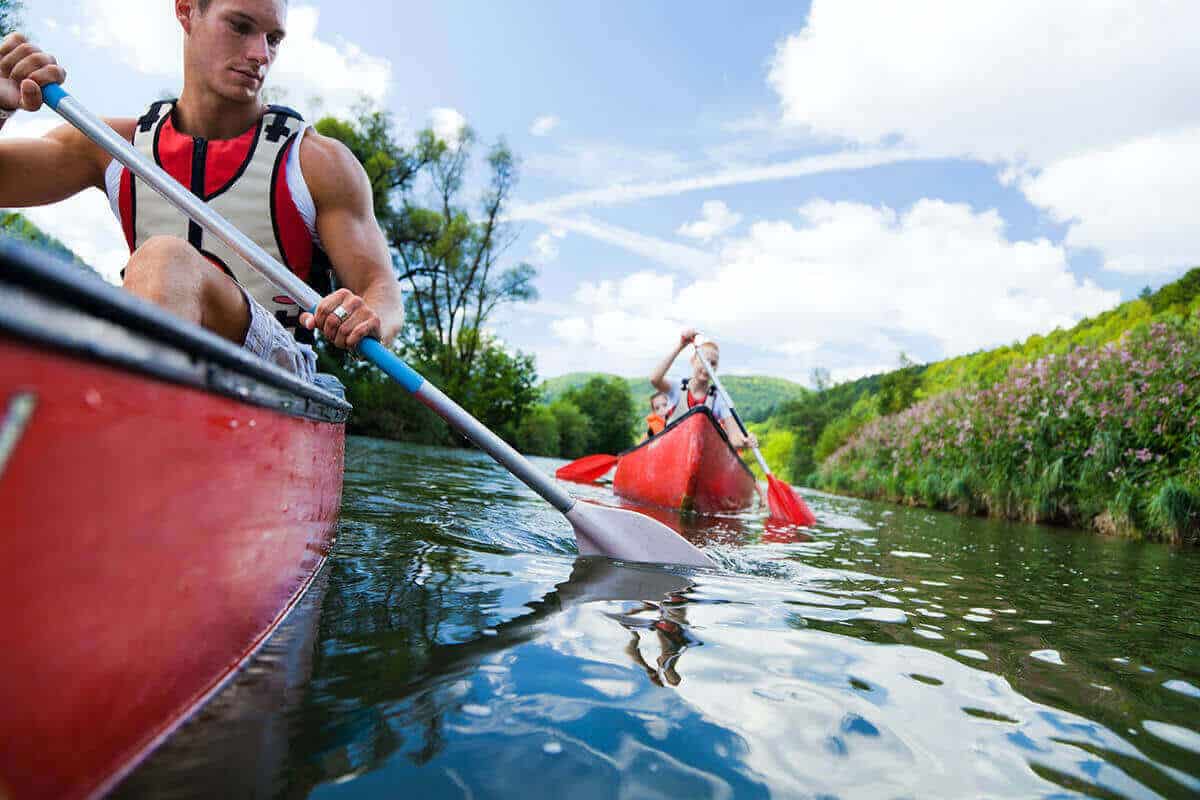
Canoes and kayaks are two of the most popular watercraft used for recreational activities. While they both have similarities, there are some key differences that should be considered when deciding which one is best for you.
Canoe vs Kayak: Design Differences
Canoe Design: Canoes typically have a flat bottom with sides that curve up to form a shallow V-shape in the middle. This design makes them more stable than kayaks, but also slower due to increased drag on the hull.
They also have an open-top design, making it easier for passengers to enter and exit the canoe.
The seating position is usually upright or kneeling, depending on the type of canoe being used.
Canoes can be made from a variety of materials such as wood, aluminum, fiberglass, plastic, and fabric-reinforced PVC for inflatable canoes.
Kayak Design: Kayaks usually have a rounded or V-shaped hull which helps reduce drag and increases speed. This shape allows them to cut through waves and currents more easily than canoes. However, it can also make them less stable than canoes.
Kayaks typically have seats that are lower than those found in canoes. This allows for better balance when maneuvering around obstacles or navigating tight spaces.
Kayaks may also be constructed from materials such as polyethylene plastic or composite fibers like Kevlar, carbon fiber, and fabric-reinforced PVC for inflatable kayaks.
Ultimately, it comes down to personal preference when choosing between these two types of boats; if you want something that offers plenty of room inside then go with a canoe, but if performance is your main priority then opt for a kayak.
Both canoes and kayaks offer different design features that make them suitable for a variety of activities, but they also have distinct differences in how they are paddled. In the next section, we will explore the differences between canoe and kayak paddling techniques.
Canoe vs Kayak: Paddle Design
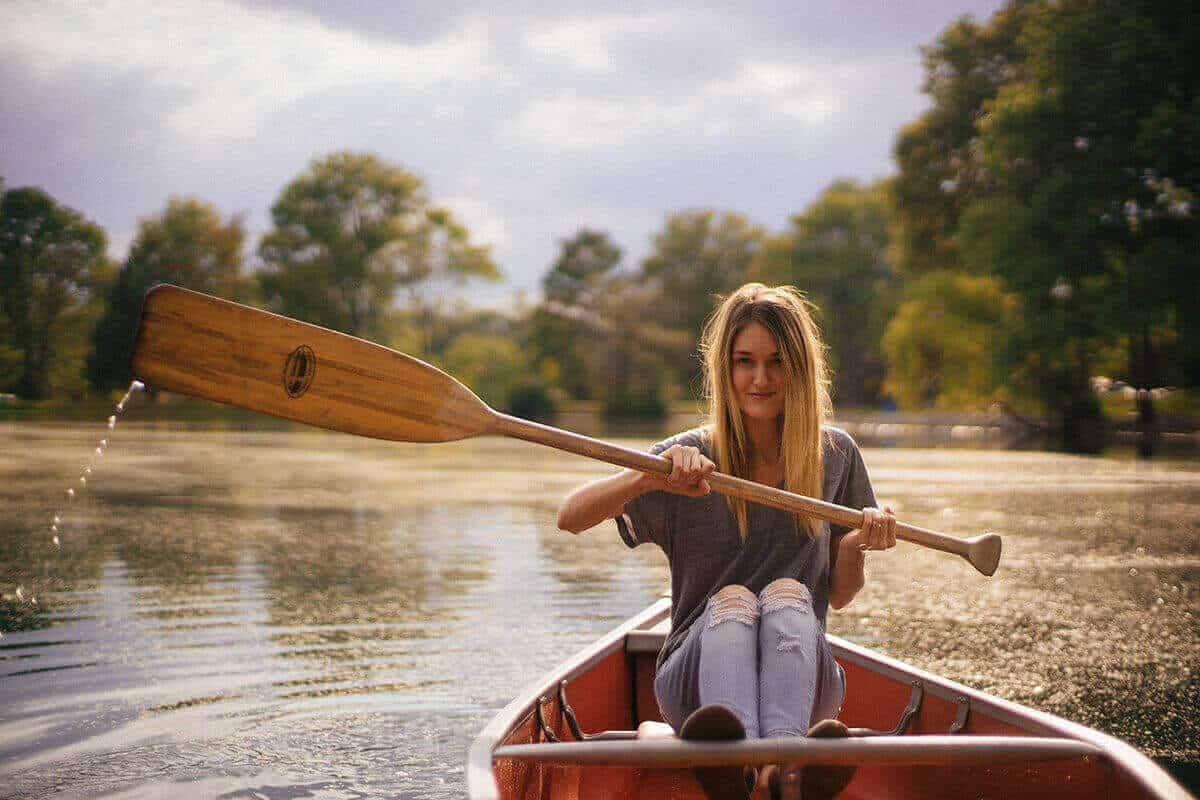
Canoe Paddle Design: Canoe paddles have a single-blade design with a T-shaped knob at the top end of the paddle. This means that canoeists need to switch hands often while paddling in order to maintain balance and keep their boat going straight ahead.
Kayak Paddle Design: Kayakers use double-bladed paddles in an alternating motion. They don’t need to switch hands. This design provides greater efficiency in movement which reduces fatigue and allows the kayaker to go faster with less effort over long distances compared to canoeists who must constantly switch hands during each stroke cycle.
Canoe vs Kayak: Paddling Differences
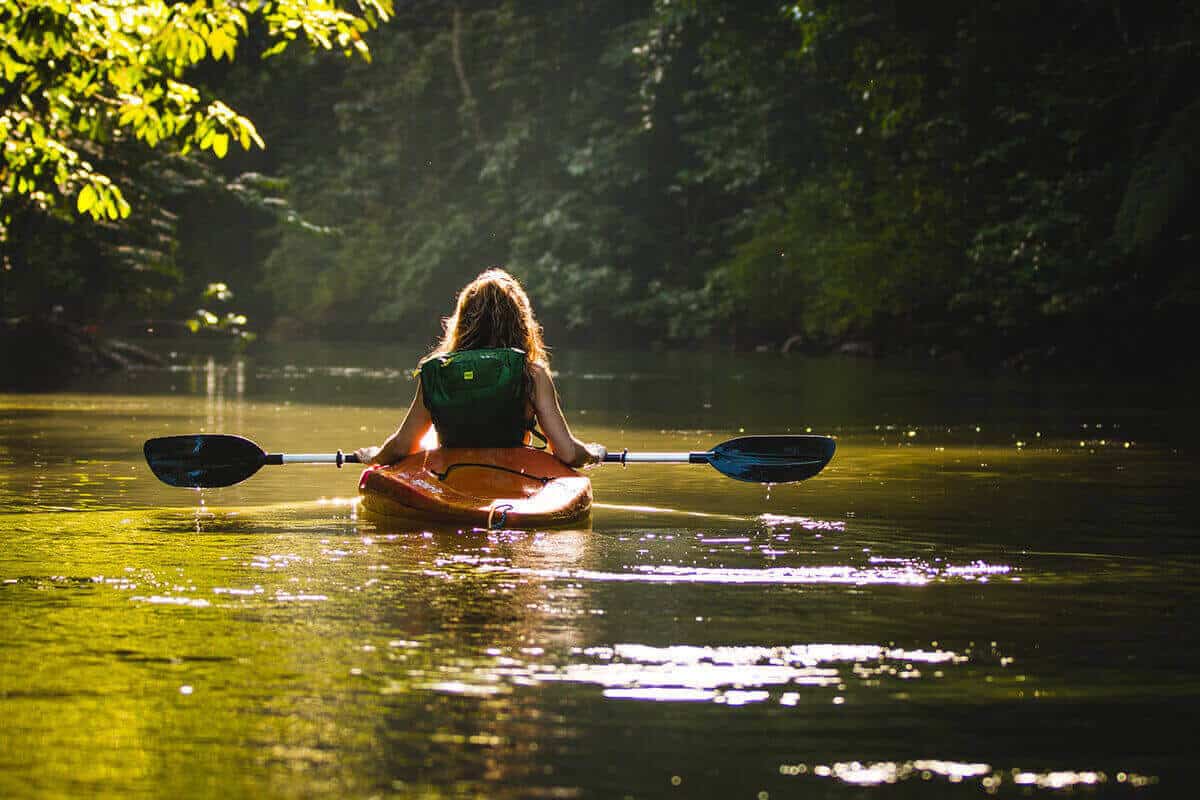
Canoe Paddling Techniques: To get the most out of your canoe experience, it’s important to understand the different paddling techniques. The two main strokes used in canoeing are forward strokes and turning strokes.
Forward strokes are used to propel the boat forward in a straight line while turning strokes allow you to turn or maneuver around obstacles.
Bracing is also an important technique that helps keep you upright when waves or wind push against your boat.
Kayak Paddling Techniques: As with canoeing, there are several key paddling techniques for kayakers to learn before heading out on the water. The two primary kayak paddles are known as “forward stroke” and “sweep stroke”.
Both strokes help move the kayak through the water but have different applications depending on what kind of maneuvers you want to make (turns, stops, etc).
Additionally, bracing can be used by experienced kayakers who need extra stability during challenging conditions such as strong winds or choppy waters.
When it comes to paddling, canoes and kayaks each have their own unique techniques that make them stand out. Next, we will explore the performance differences between these two vessels to help you decide which one is best for your needs.
Canoe vs Kayak: Performance Differences
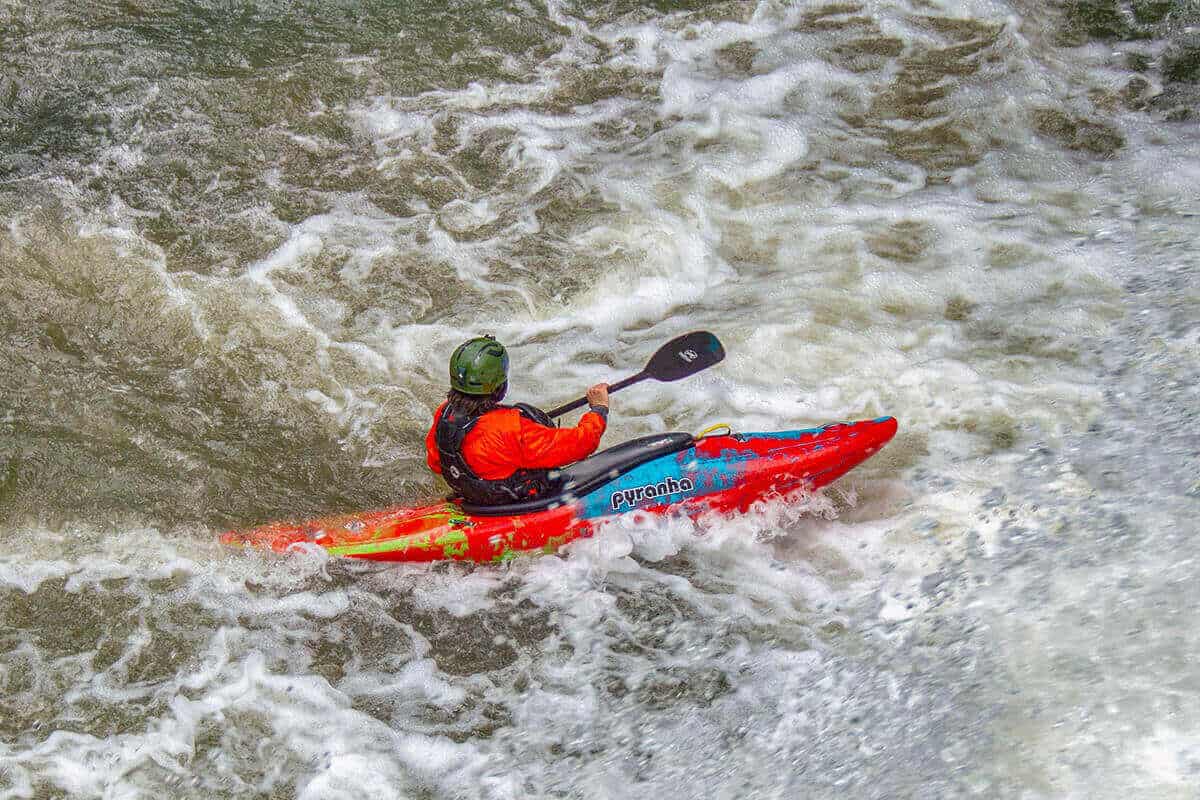
Canoe Performance Characteristics: Unlike kayaks, canoes are typically longer and wider. The length tends to help them track better and the width makes them more stable on the water.
The length and tracking benefits of canoes make them faster over long distances. They, however, have a tradeoff they require more effort to turn or maneuver in tight spaces.
Canoes also have side walls that rise higher above the waterline than those of kayaks. This in combination with the flat bottom can impede progress and affect tracking when the forces of wind and waves push against the sides of a canoe.
Additionally, the flat bottom design also makes them slower than kayaks over short distances due to the increased hull drag on the surface of the water.
Kayak Performance Characteristics: Most kayaks have a narrower and lower profile, often making them less stable on the water but easier to maneuver around obstacles or tight spaces. Their shape also reduces drag making it easier for paddlers to quickly and efficiently navigate shorter distances.
Their pointed ends help them cut through waves and wind better than canoes, allowing for improved tracking ability in choppy waters or strong winds. However, due to their shorter length, they don’t have as much speed potential as canoes do when paddling long distances across open waters.
When comparing performance characteristics between canoeing and kayaking there are several key differences that should be taken into consideration before deciding which type of boat is best suited for your needs.
Canoes tend to be faster over long distances due to their increased length while kayaks offer superior maneuverability in tighter areas thanks to their narrow widths and pointed ends.
Additionally, canoes may struggle with tracking in windy conditions while kayaks perform better under those same circumstances due to their design features such as a lower profile and a pointed bow and stern sections designed specifically for cutting through waves and wind resistance efficiently.
Finally, storage capacity is another factor worth considering. Since most kayaks are smaller than most canoes they tend to provide less space for passengers and items like fishing gear or camping supplies.
Canoes and kayaks both offer unique performance characteristics, depending on the activity. It is important to consider these differences when deciding which boat is best for you.
Canoe vs Kayak: Stability & Maneuverability
Canoes tend to be more stable on open waters than kayaks due mainly due to their wide beam width. This, however, comes at a cost since being wider also limits maneuverability making it harder to turn sharply especially if loaded down with gear.
Conversely, a kayak’s narrow beam width provides great speed and allows users to easily navigate around obstacles found along shorelines, rivers, and streams plus make sharp turns quickly without losing a great deal of momentum thanks to its lower center gravity.
Canoe vs Kayak: Load Capacity
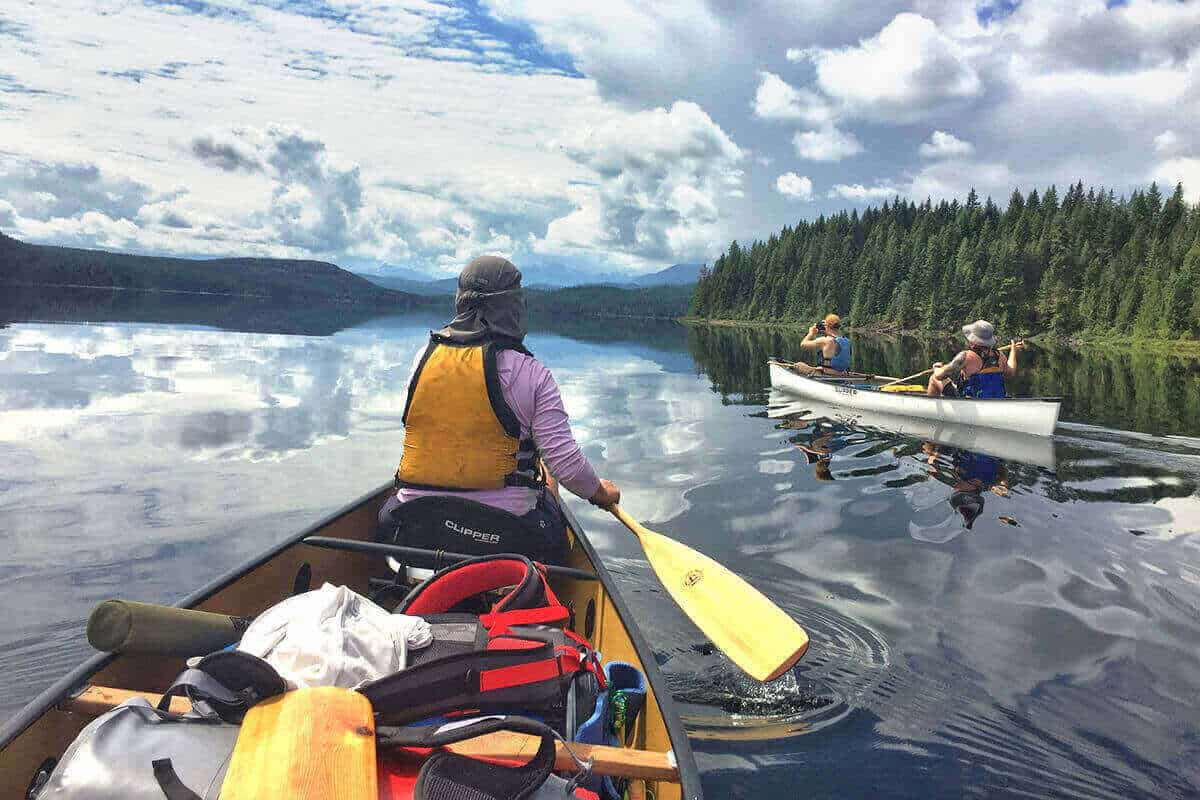
Canoes have a higher load capacity than most kayaks. This means that canoes can hold more people and gear. Load capacities of 2-4 people and 600 – 1400 lbs are quite common. Larger inflatable kayaks can, however, come close to matching the weight capacity of a canoe.
Inflatable Kayaks with high load capacities:
| Inflatable Kayak | Load Capacity |
|---|---|
| Sea Eagle 420x Explorer | 3 Persons or 855 lbs. |
| Sea Eagle 465ft FastTrack | 3 Persons or 795 lbs |
| Aquaglide Blackfoot Angler 160 | 2 Persons or 800 lbs |
| Aquaglide Cirrus Ultralight 150 | 2 Persons or 600 lbs |
| Aquaglide Chelan 155 | 2 Persons or 600 lbs |
| Aquaglide Deschutes 145 | 2 Persons or 600 lbs |
| Aquaglide McKenzie 125 | 2 Persons or 600 lbs |
| AIRE Super Lynx Kayak | 2 Persons or 600 lbs |
| BOTE Zeppelin Aero 12′6″ | 2 Persons or 600 lbs |
For more on understanding kayak load capacities, check out Is There A Weight Limit For Kayaks?
Check out my BOTE Zeppelin Aero Review to learn more.
Different Types of Canoes
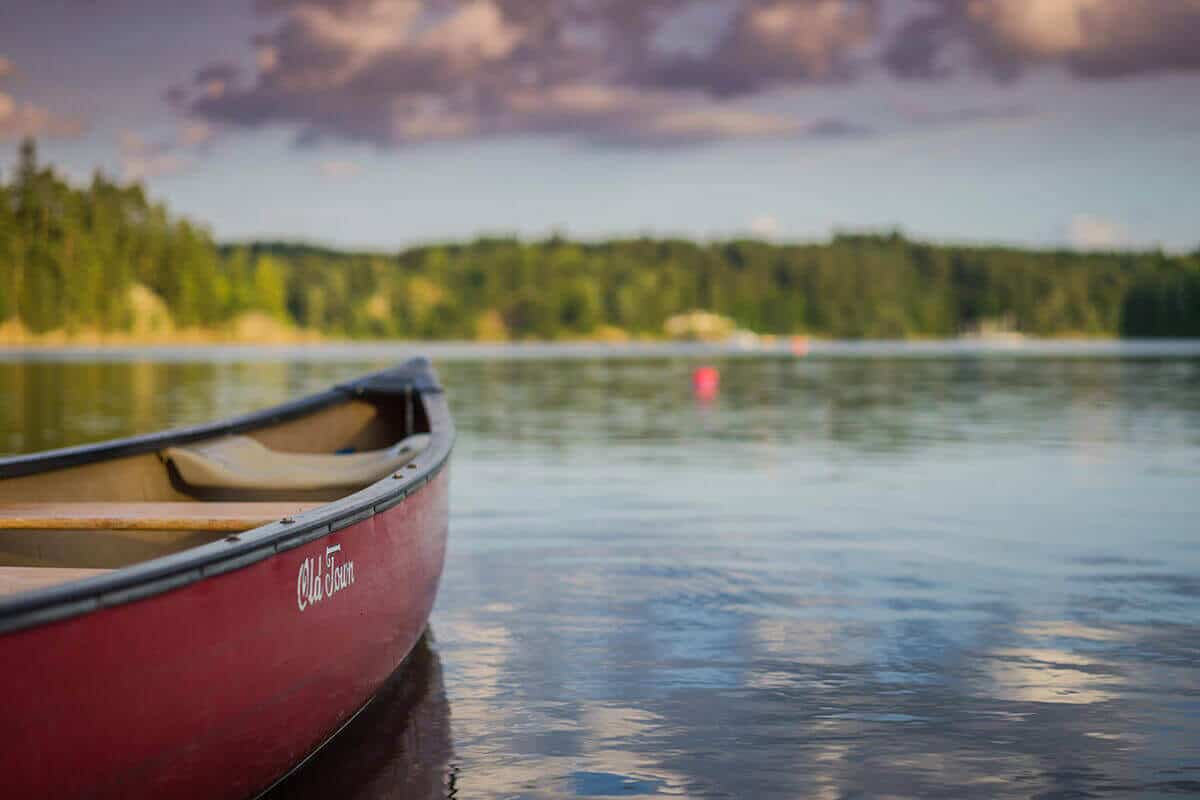
Canoes come in a variety of shapes and sizes, each designed for different purposes.
Whether you’re looking for an easy-to-use recreational canoe or something more specialized like a whitewater or fishing canoe, there is something out there for everyone.
There are solo canoes, 2-person canoes, 3-person, or more.
The most common types are:
Recreational Canoes
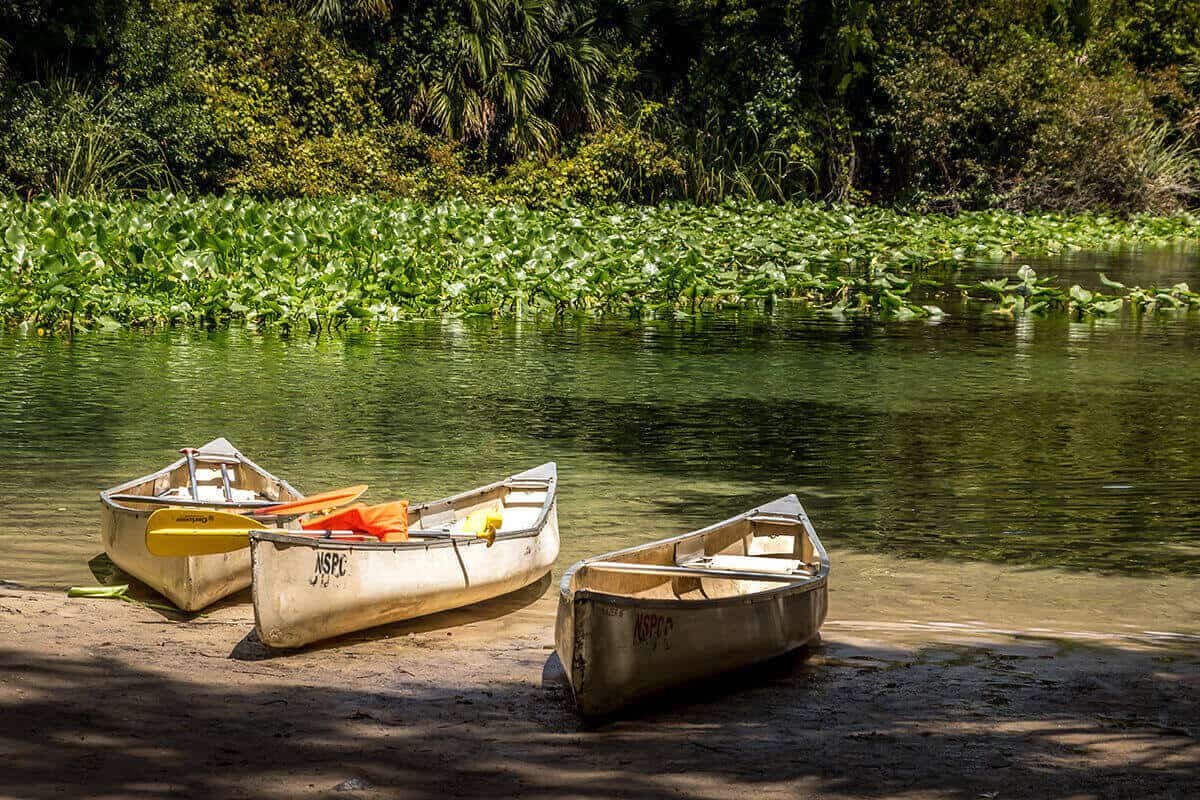
Recreational canoes are designed for general use on calm waters such as lakes and slow-moving rivers.
These canoes typically feature open decks with plenty of room for gear storage and passengers. They are usually made from fiberglass, plastic, or fiberglass materials that make them lightweight yet strong enough to handle rough waters.
Most recreational canoes also have large flat bottoms which provide stability while paddling in calm water conditions but may not be ideal when maneuvering through rapids or other turbulent waters. These canoes are ideal for beginners who may not have the experience necessary to handle more advanced boats.
Whitewater Canoes
Whitewater canoes are designed specifically for navigating challenging rivers with fast-moving currents and Class III rapids or higher.
These boats feature shorter lengths than recreational models which makes them easier to maneuver through tight turns while their hulls are often wider at the center providing extra stability when navigating choppy waters.
They typically have a pointed bow and stern that help cut through waves quickly without getting stuck on rocks or debris along the way.
They also tend to be much narrower than their counterparts so they don’t get pushed around by powerful eddies and whirlpools during extreme river runs.
In addition, they tend to be made from heavier materials such as fiberglass or Kevlar which allows them to withstand impacts better than lighter models would be able to do so without damage occurring over time due to wear and tear from frequent usage in turbulent environments.
Touring Canoes
Touring canoes offer a good balance between speed and stability making them a great option for a long-distance canoe trip on flatwater bodies such as lakes or mild rivers where paddlers will need enough storage space onboard but won’t necessarily require the maneuverability that whitewater models provide.
They are generally constructed out of either wood or composite material and tend to have longer lengths than recreational versions allowing paddlers greater efficiency when covering larger distances over extended periods of time.
In addition, touring canoers will appreciate the increased speed offered by these vessels thanks to their efficient hull designs which reduces drag significantly compared to wider canoes.
Fishing Canoes
Designed with anglers in mind, fishing canoes combine many features found in both recreational and touring models into one package.
Typically featuring wide beams and shallow drafts, these vessels allow fishermen access to areas that other boats may not be able to reach due to their size limitations.
Many fishing canoe designs incorporate additional seating along with elevated seats, rod holders, live wells, anchor systems, trolling motors, built-in tackle boxes, and more providing the conveniences and necessary tools needed when targeting various fish species regardless of whether in a lake, pond, bay, or ocean setting.
Inflatable Canoes
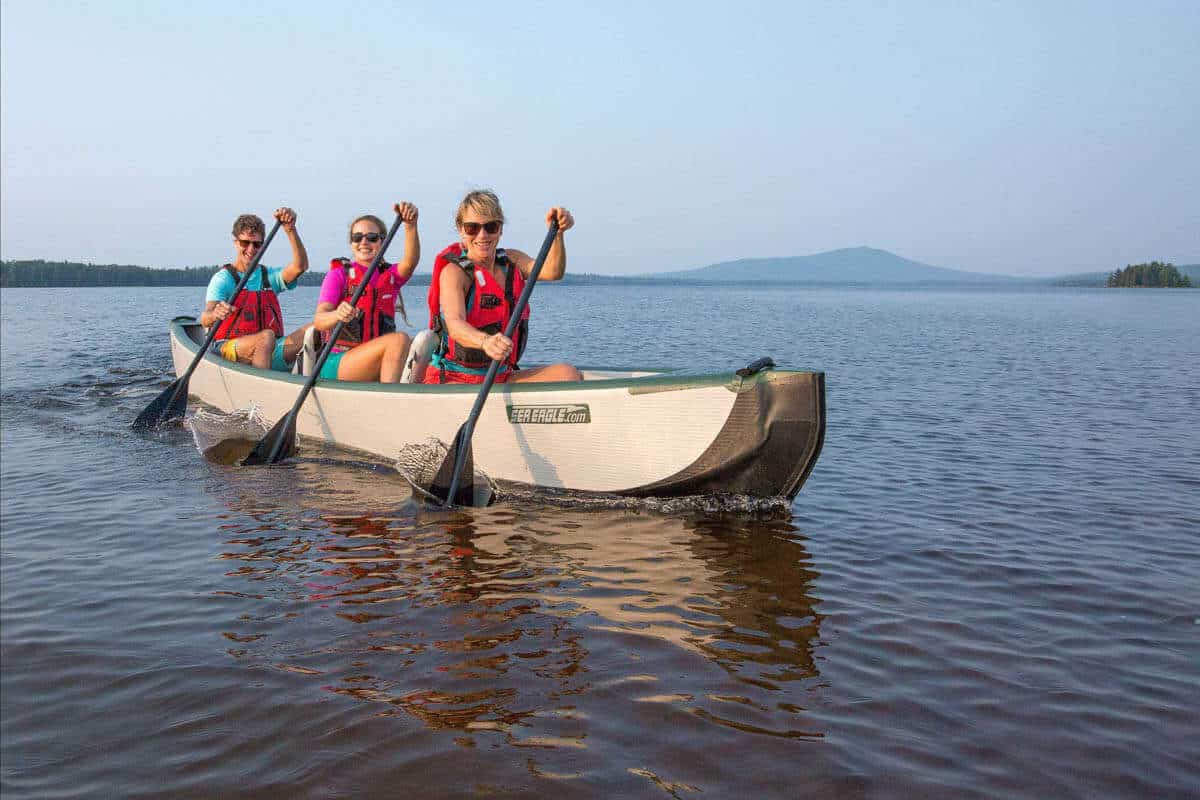
Inflatable canoe options exist for those who don’t want the hassle associated with transporting hardshell canoes!
Made from tough, fabric-reinforced PVC material and featuring multiple air chambers, these highly portable canoes easily fit into carry bags and backpacks to be stored in small spaces allowing users to take them anywhere without worrying about vehicle size restrictions! Inflatable canoes are easy to store in the garage or an apartment closet.
Although these inflatable models may not perform quite as well as their hardshell counterparts they still offer great options especially if portability is a key factor in deciding which type boat best suits your needs!
If you have never seen a full drop-stitch inflatable canoe, check out the Sea Eagle TC16 Travel Canoe.
Flatwater Racing Canoes
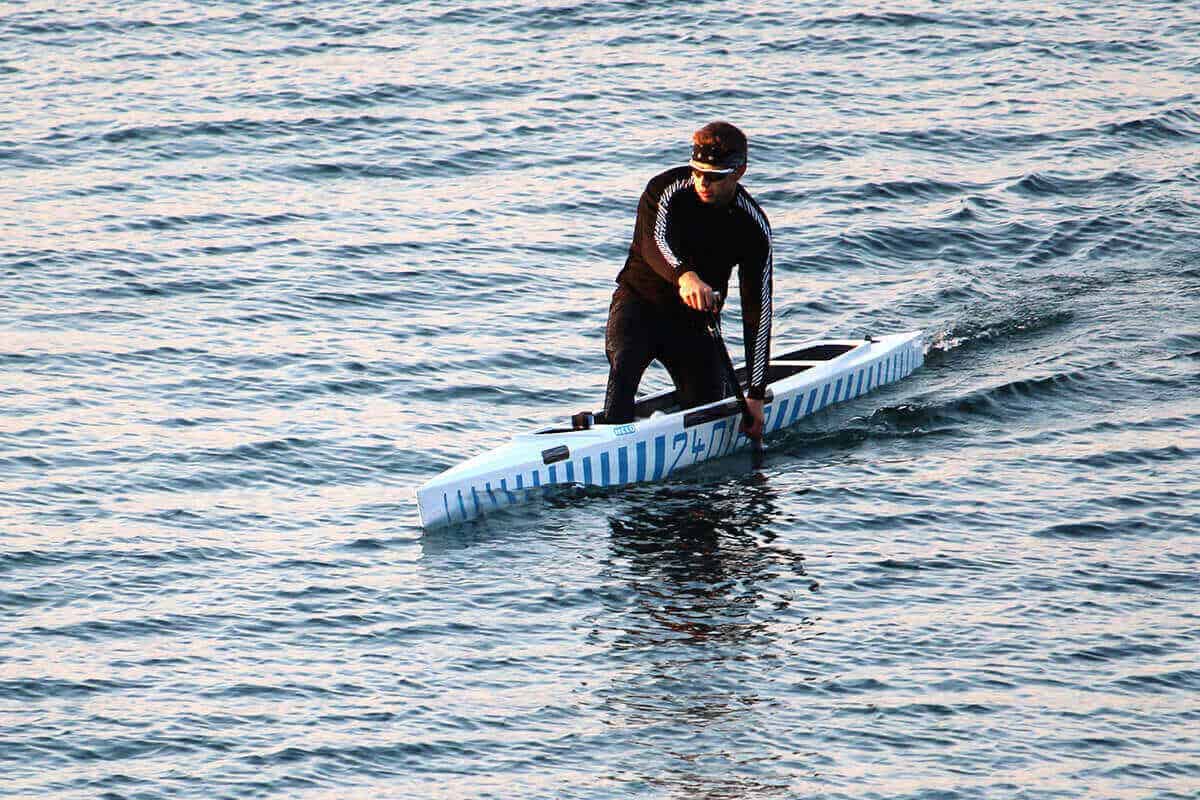
Flatwater racing canoes are touring canoes developed for competitive racers seeking every advantage possible against competitors.
Racers sprint straight ahead with no turns.
These canoes have narrow profiles combined with long lengths enabling maximum speed potential over short distances. Racing canoes are specifically designed for the purpose of racing and lack the versatility for everyday use.
Whitewater Slalom Canoes
Whitewater slalom canoes are whitewater canoes designed for competitive races where a watercourse marked with poles or hanging gates is navigated to achieve the fastest time possible. If the poles or gates are touched, points are deducted from the racer’s score.
Choose wisely based upon your experience level and skill set ensuring you purchase one best suited towards meeting your individual needs!
Different Types of Kayaks
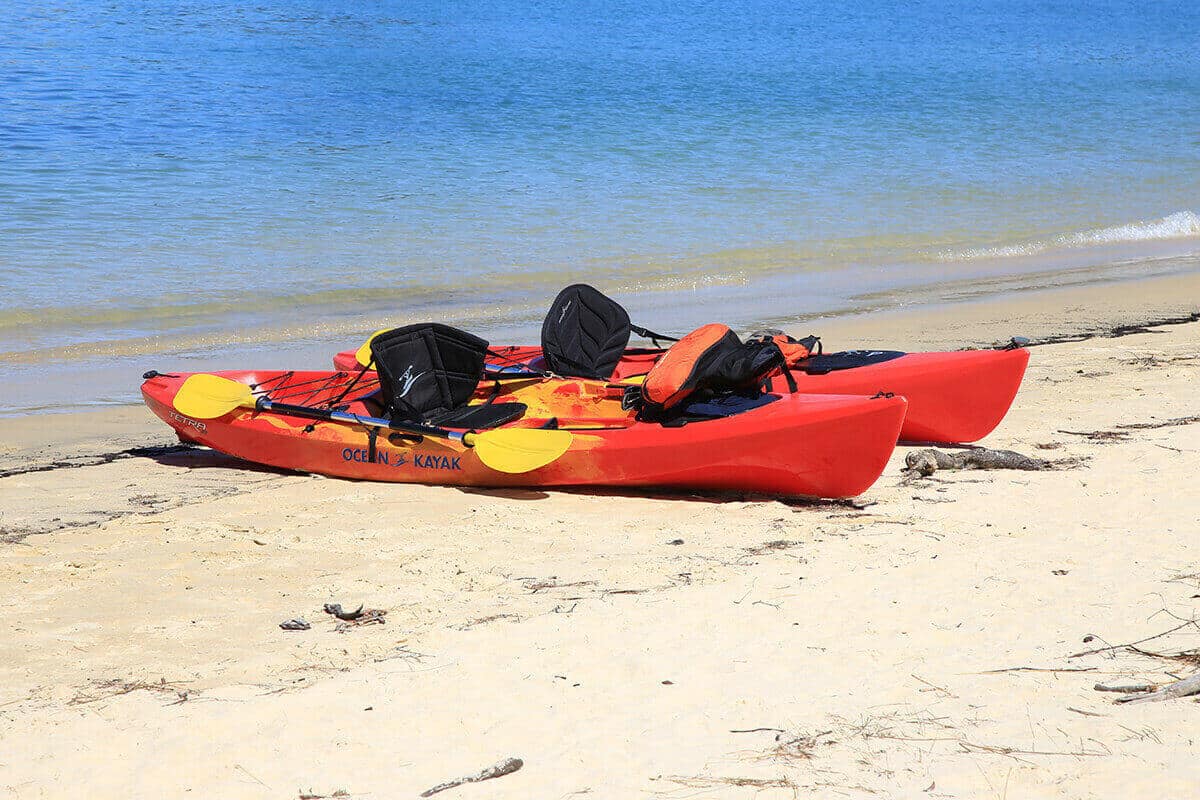
Kayaks are a popular choice for those looking to explore the water. They come in many different shapes, sizes, and styles to meet the needs of all types of paddlers and the challenges of all water types whether that be flatwater, whitewater, or ocean waves.
There are many different types of kayaks available on the market today. Let’s look at the different types.
Sit-In Kayaks
Sit-inside kayaks offer more protection from wind and waves due to their enclosed design but may require some additional skill when entering or exiting them due to their lower profile in the water.
These boats typically have adjustable seating positions so that you can customize your ride based on your size and preferences.
They are most often solo kayaks though tandem models are available from select manufacturers.
Sit-On-Top Kayaks
Sit-on-top kayaks are great recreational kayaks for those who want easy access in and out of the boat without having to climb inside a cockpit while still offering stability on the water.
These boats feature an open top with high/low, adjustable, removable seats or seating molded directly onto the hull so you can just sit down and paddle away! Some models even have adjustable footrests or molded foot braces so you can find the perfect fit while paddling.
They also tend to be more affordable than other types of kayaks and often come with features such as rod holders, storage compartments, and adjustable footrests.
A sit-on-top kayak may be a solo paddler, 2-person, 3-person, or more.
There are different types of sit-on-top kayaks. Recreational models are perfect for beginners who want an enjoyable experience without having too much technical knowledge about paddling techniques or navigation skills.
Recreational Kayaks
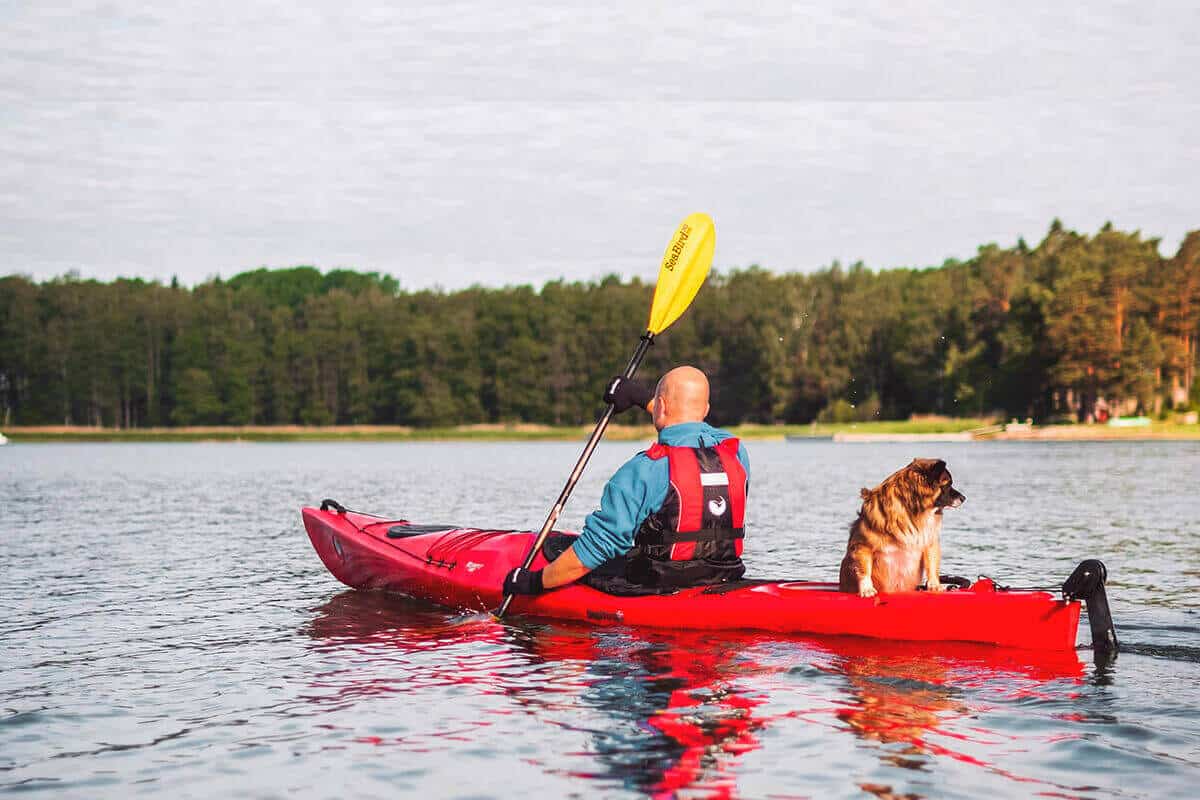
Recreational models generally feature wide hulls that make them stable in calm waters, making them ideal for lakes, ponds, slow rivers, bays, estuaries, etc., where conditions remain relatively consistent throughout the day.
They offer plenty of room for gear storage due to their wider beam widths (the distance between each side).
This makes them ideal if you plan on taking long trips where packing food or camping supplies may be necessary. Many recreational models also feature comfortable seats, making them great choices if comfort is important during longer outings!
Touring Kayaks
Touring kayaks are also called ocean kayaks, sea kayaks, or expedition kayaks. They have longer narrower hull designs that allow them to cut through waves more efficiently than other types. They are built for speed and distance over maneuverability for navigating obstacles like rocks or logs found in rivers or streams.
They often feature rudder systems that help keep track straight even when faced with strong winds or currents. These boats are ideal for kayaking expeditions on open bodies of water such as oceans and large lakes where obstacles are less common.
Whitewater Kayaks
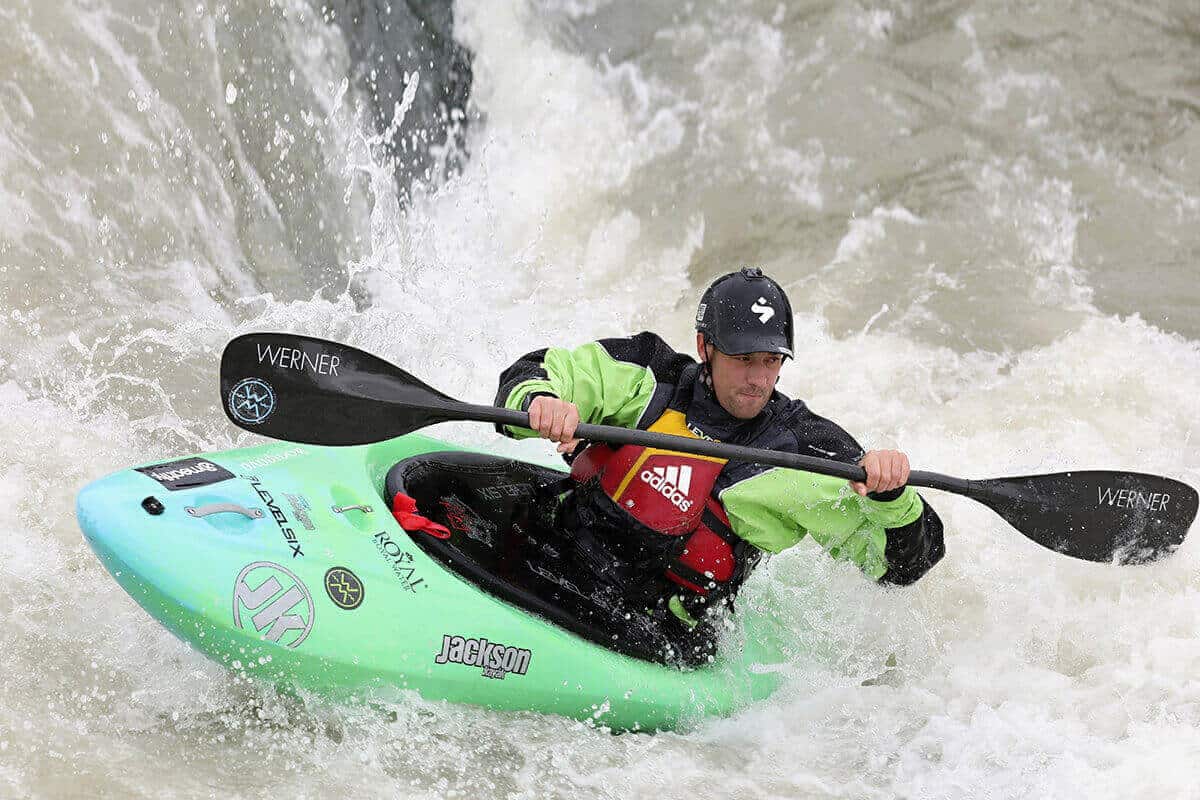
If whitewater kayaking is your goal, you want a whitewater kayak specifically designed to handle rapids up to Class V difficulty levels while providing adequate protection against rocks and debris found within rivers and streams alike!
Whitewater models generally have shorter lengths combined with higher sides giving increased maneuverability needed to navigate through narrow passages between rocks while providing extra buoyancy during drops off ledges into pools below. They also have combing that allows the kayaker to attach a spray skirt to prevent water from entering the cockpit.
Fishing Kayaks
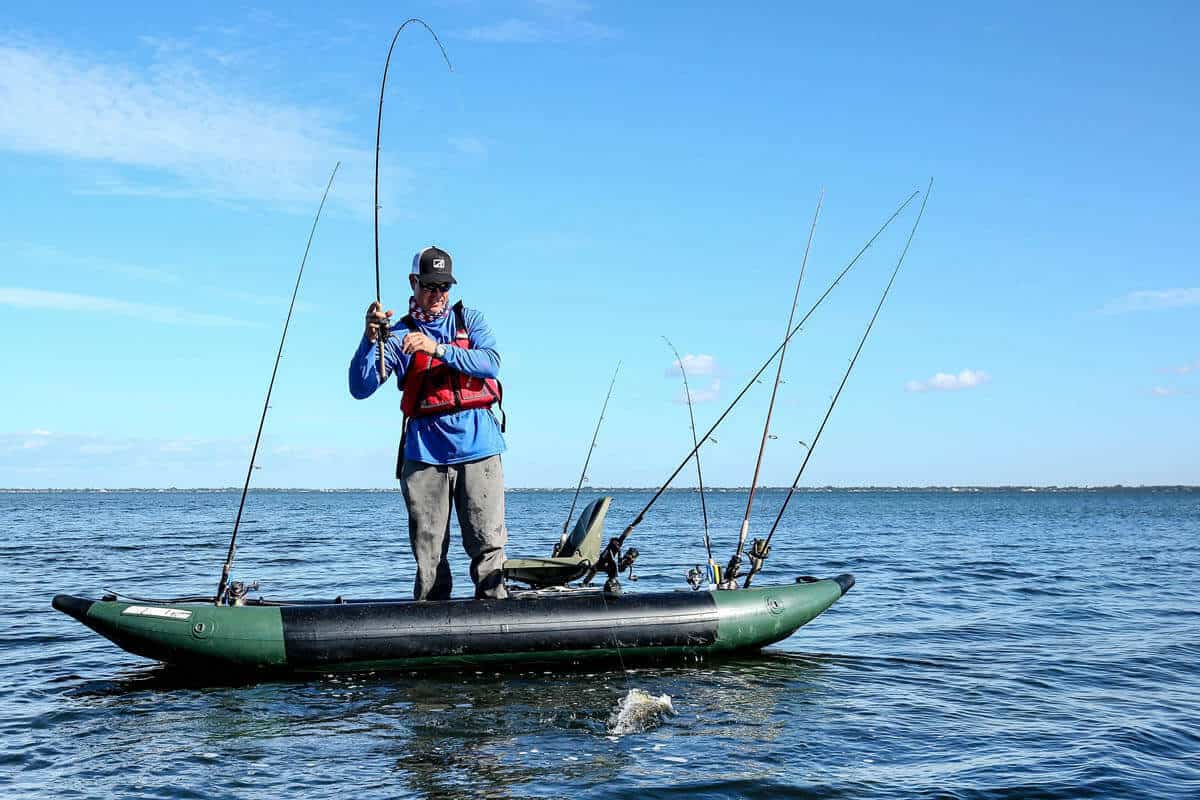
Anglers often opt for hard-shell or inflatable fishing kayaks. These are specially designed recreational kayaks featuring rod holders, live wells, anchor systems, fish finders, bait trays, tackle boxes, etc.
These boats have wider beams (width) that provide greater kayak stability for standing while casting and reeling in that trophy catch.
Their speed may not be able to reach the speeds of touring kayaks or standard recreational kayaks while paddling. However, pedal fishing kayaks and motorized fishing kayak models are available that not only provide speed for covering more territory without having to expend extra energy from paddling alone! but the motorized options free your hands for fishing.
Surf Kayaks
Surf kayaks are used to surf ocean waves. They are similar in design to whitewater kayaks due to their need for tight turns and hairpin maneuvers.
Flatwater Racing Kayaks
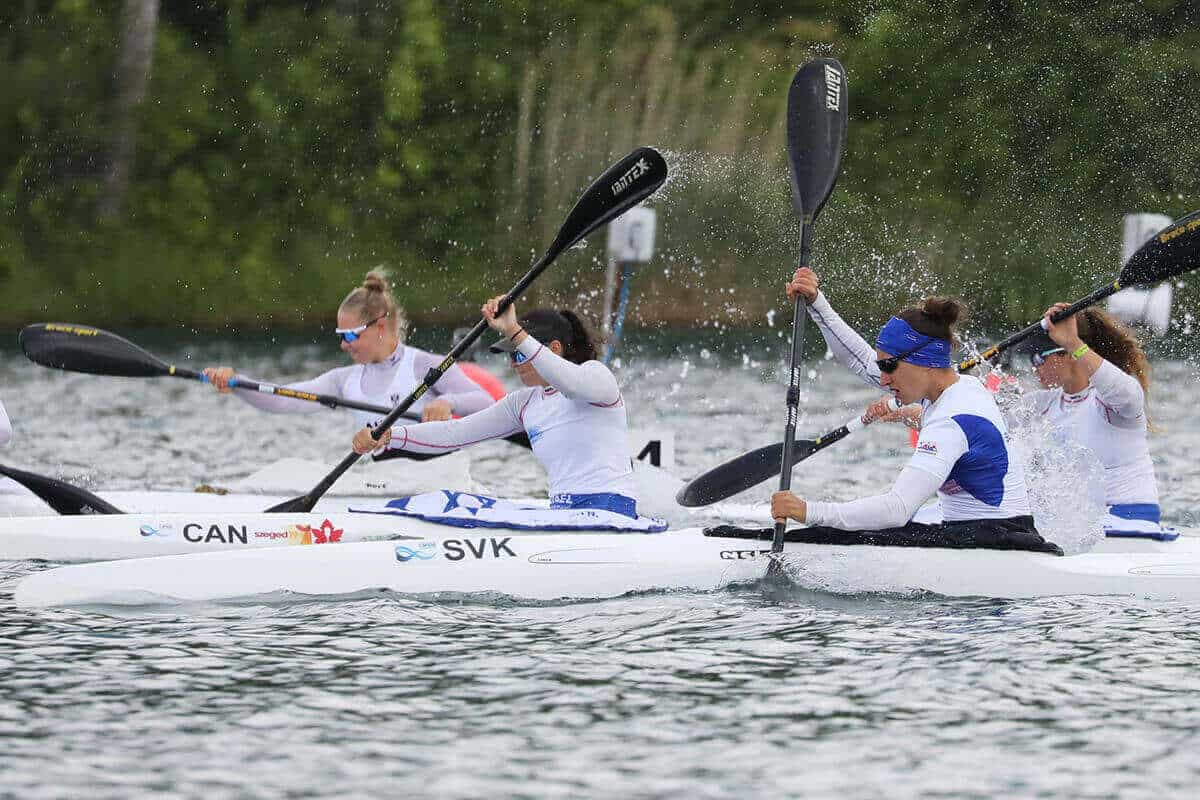
Kayak speed is extremely important here. Flatwater racing kayaks are touring kayaks developed for competitive racers seeking every advantage possible against competitors.
These kayaks feature sleek low profiles combined with long lengths enabling maximum speed potential over short distances. These vessels, however, lack the versatility found in other styles mentioned above making them less desirable for everyday use outside races themselves.
Whitewater Slalom Kayaks
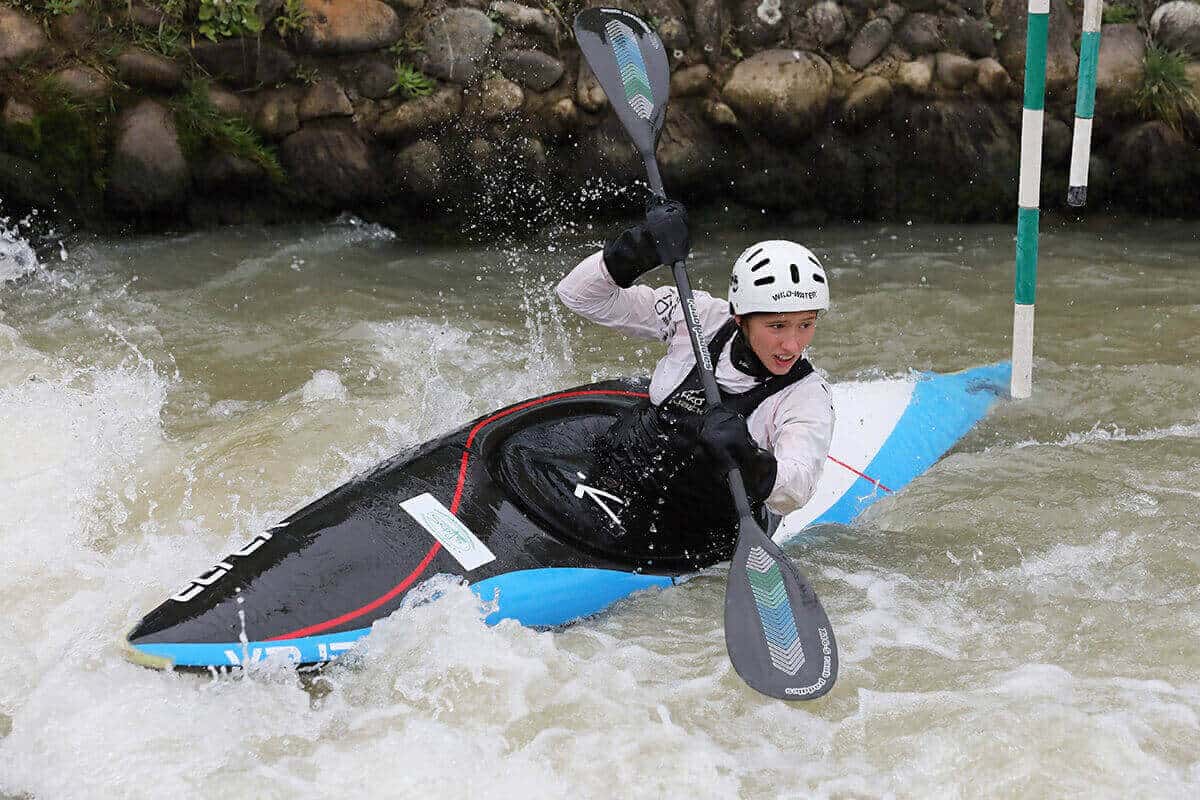
Whitewater slalom kayaks are whitewater kayaks designed for competitive races where the kayaker navigates a watercourse marked with poles or hanging gates to achieve the fastest tie possible. If a competitor touches a gate, points are deducted from their score.
Inflatable Kayaks
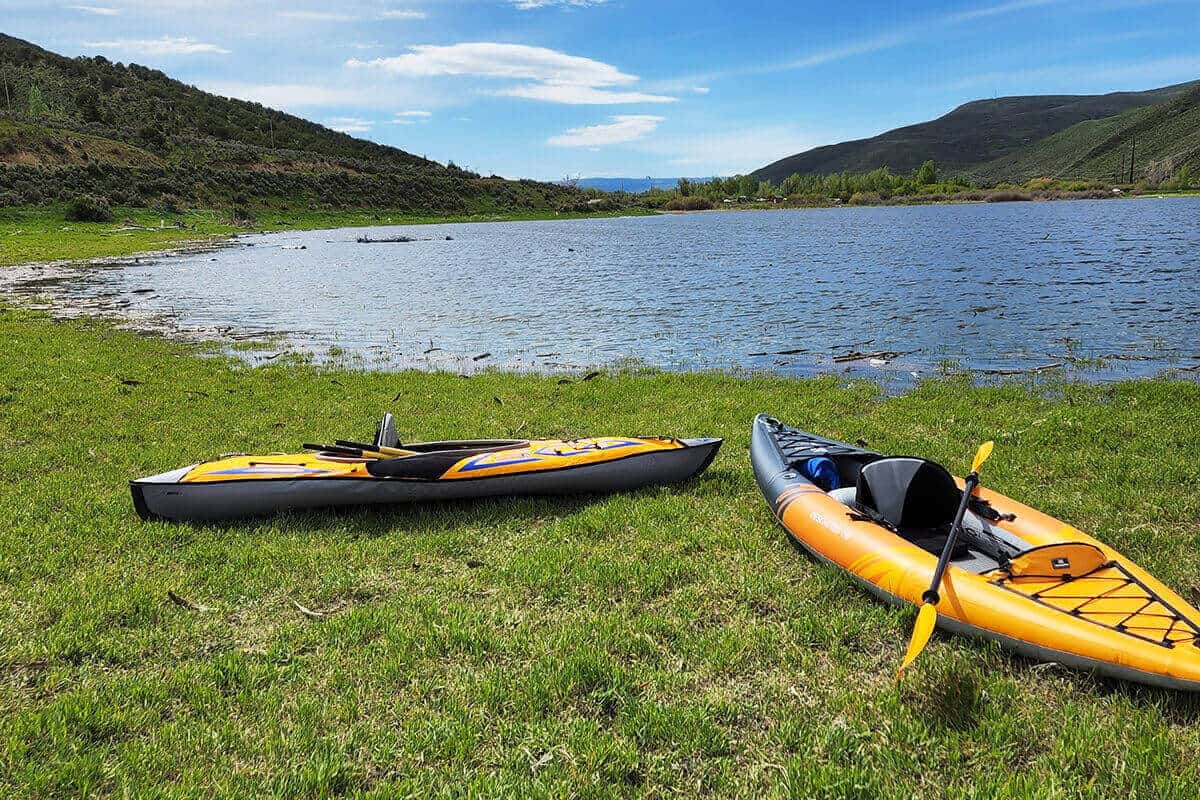
Inflatable kayaks combine portability and convenience. Just deflate and fold up the kayak into a carry bag when on the go. They easily fit in the trunk of a car and can be stored in a closet or on a shelf in the garage when you get home. They can be taken anywhere you go, even as check-in baggage on a plane!
Inflatable kayaks vary by type: recreational, touring, whitewater, and fishing. Inflatable kayaks come in both sit-on-top raft-style and sit-in versions with optional spray skirts.
These kayaks often have higher weight capacities and come in models for solo, tandem, and 3-person paddling. Four-person inflatable kayaks are a bit rare but are available from Decathlon and Hobie.
Advantages and Disadvantages of Canoes
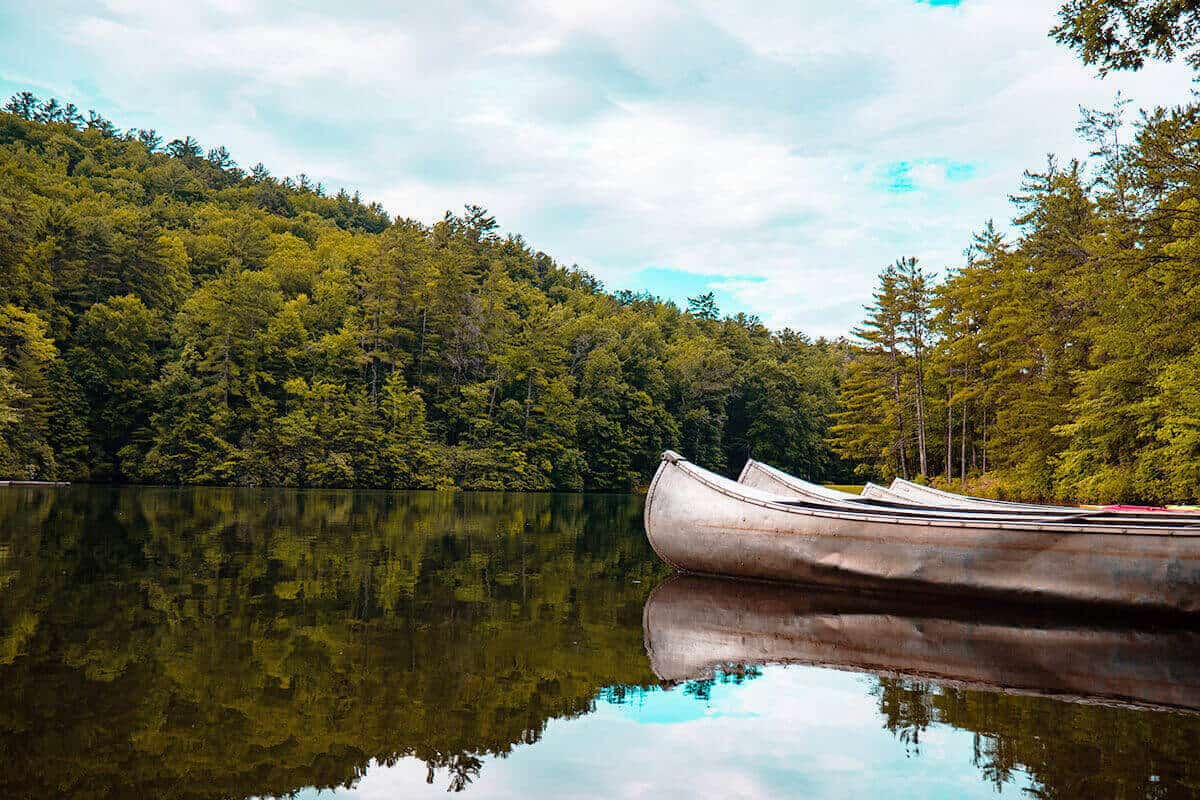
Canoes offer a variety of advantages for outdoor enthusiasts. One of the main benefits is their large load capacity, which makes them ideal for camping trips and extended journeys on the water. The wider hulls of canoes make them very stable in rough water conditions. This is a great plus for beginners who may not be comfortable with a kayak. Furthermore, their length improves their tracking capabilities so you don’t have to constantly adjust your course while paddling.
Canoes are also much easier to enter and exit than sit-in kayaks.
Unfortunately, there are some disadvantages associated with using canoes as well. The biggest issue is that they tend to move slower than kayaks due to their design and length; this means it will take longer to get from point A to point B if you’re traveling by canoe instead of kayak. Additionally, while tracking well on open waters like lakes or slow-moving rivers is an advantage, maneuvering in tight spaces such as narrow rivers or streams can be difficult due to the size and shape of most canoes compared with smaller kayaks.
A couple more disadvantages of canoes are that they are more difficult to paddle solo and they are larger and heavier.
Canoes aren’t huge boats but they are larger than kayaks and thus take up more storage room in a garage or shed. Their size makes them more difficult for one person to lift alone and often require a trailer for transport. The exception to this would be an inflatable canoe that folds up to fit into a carry bag that easily fits in the back of a truck, car, or SUV.
Canoes are a great way to explore the outdoors, but it’s important to consider their advantages and disadvantages before deciding which boat is right for you. Now let’s take a look at the advantages and disadvantages of kayaks.
For those that love lists like I do, let’s list the pros and cons of canoes…
Advantages of Canoes
- Large load capacity for passengers and gear
- Great for longer trips
- Wider hulls provide improved stability
- Longer lengths provide excellent tracking
- Easier to enter and exit than sit-in kayaks and some sit-on-tops too
- Provide a higher seat position than most kayaks for a better view of your surroundings
Disadvantages of Canoes
- Larger and heavier than the average kayak which makes them more difficult to transport and store
- Require more physical effort to paddle than a kayak
- More difficult than a kayak to paddle solo
- More difficult to maneuver than most kayaks
- Their high sides make them more susceptible to being pushed off course by winds and waves
Advantages and Disadvantages of Kayaks
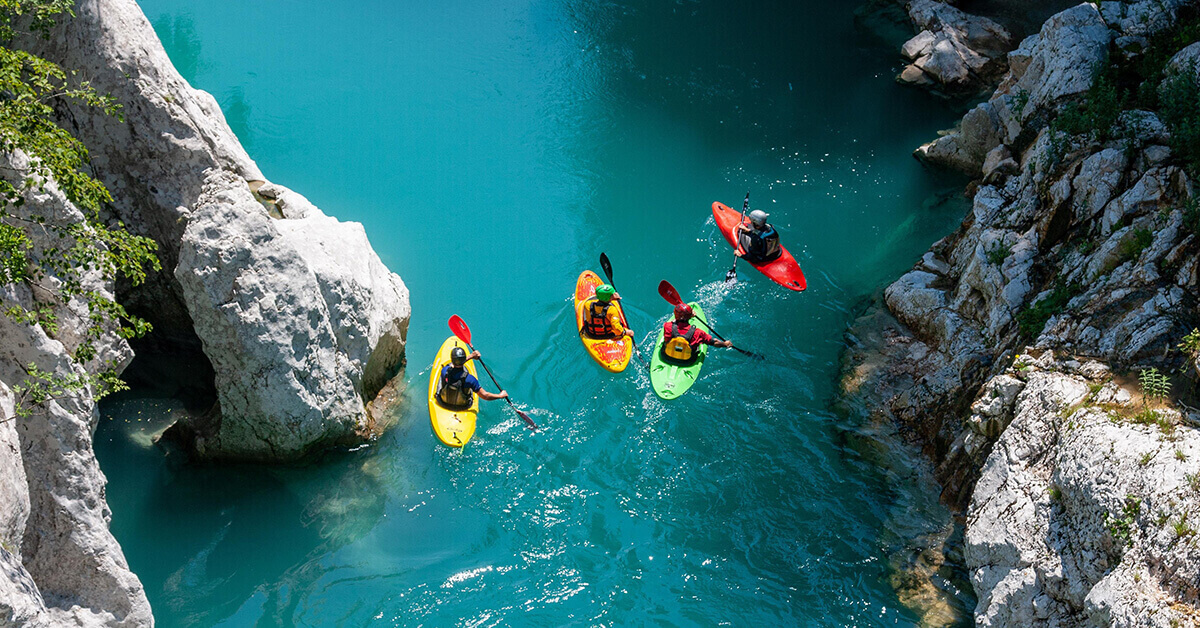
Kayaks are a popular choice for outdoor enthusiasts looking to explore rivers, lakes, and oceans. They offer several advantages over canoes.
Kayaks tend to require less effort when paddling since they sit lower in the water compared with canoes which makes them great for long trips where you need sustained speed over distance. Additionally, kayaks are highly maneuverable in tight spaces and around obstacles that require faster, sharper turns for navigation.
Another advantage kayaks have over canoes is that they are much easier to paddle solo. Canoeing is most efficient when two people work together in unison to keep the boat moving straight while kayaking only requires one person paddling with alternating strokes on each side of the boat.
Finally, kayaks typically weigh far less than the average canoe and take up less space in your garage. Many kayaks can easily be carried by one person and lifted into the back of a truck or onto a roof rack. There are also inflatable kayaks that fold up into a carry bag that can be stored in the trunk of a car or in the back of an SUV.
There are, however, some drawbacks associated with kayaks when compared to canoes. They sit low in the water which limits visibility unless you have a sit-on-top or inflatable kayak stable enough to stand up in. Additionally, most kayaks have a lower load capacity when compared to a canoe meaning it seats fewer people and holds less gear.
Here’s a quick list of the kayak pros and cons…
Advantages Of Kayaks
- Less paddling effort than a canoe
- Excellent maneuverability and speed
- Generally lighter and easier to transport and store than a canoe
- Kayak seats often have better back support than canoe seats
- Adjustable footrests and ergonomic seats on many kayak models offer improved comfort
- Sit-in kayaks, especially with a spray skirt, are better at protecting the paddler and limited gear from the elements
- Double-blade paddles are more efficient for paddling
- Some models feature retractable rudders and skegs for improved tracking and maneuverability
Disadvantages Of Kayaks
- Lower load capacities limit gear and the number of passengers
- Sit-in kayaks lack ventilation inside which can be uncomfortable on hot summer days
- The average kayak is not as stable as a canoe
- Limited visibility when sitting in models that place you close to the waterline
- Sit-in kayaks are more difficult to get in and out of than a canoe
Safety Considerations for Using Canoes or Kayaks
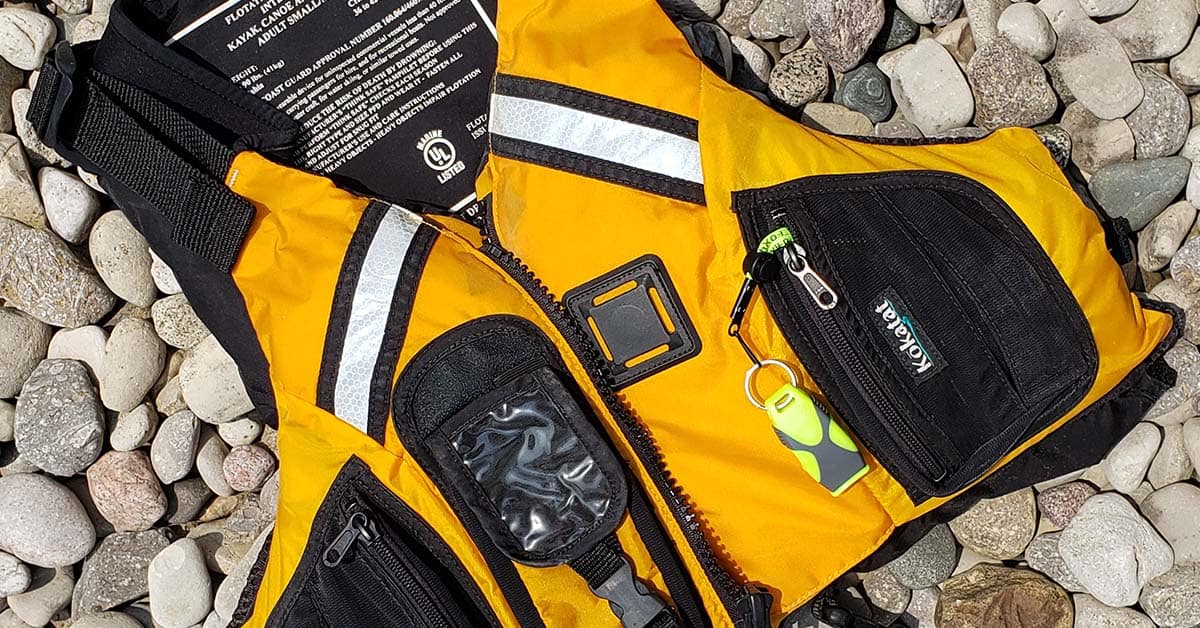
Canoe and Kayak Safety Equipment
It is important to wear the appropriate canoe or kayak safety equipment. This includes wearing a life jacket at all times and making sure that it fits properly.
It is also recommended to wear protective clothing such as quick-drying pants and shirts, as well as shoes with good grip on slippery surfaces.
Additionally, having an emergency whistle on hand can be useful in case of distress while out on the water.
For more on canoe and safety equipment see:
- Safety Whistles For Outdoor Emergency Preparedness
- Canoe & Kayak Safety Equipment Checklist
- Boating Safety Basics For Paddle Boaters
Weather Conditions to Consider When Using a Canoe or Kayak
Before embarking on any paddling trip, it is important to check the weather conditions beforehand and plan accordingly.
Strong winds can cause choppy waters which make paddling difficult and dangerous. In addition, thunderstorms should be avoided due to potential lightning strikes which could put you in danger if caught out in open water.
If possible, try planning your trips around days with calm winds and sunny skies for optimal enjoyment of your time spent outdoors.
It is important to consider safety when using a canoe or kayak, from selecting the right gear and knowing how to handle different weather conditions, to properly cleaning and storing your boat. Now let’s take a look at some maintenance tips for owning a canoe or kayak.
Maintenance Tips for Owning a Canoe or Kayak
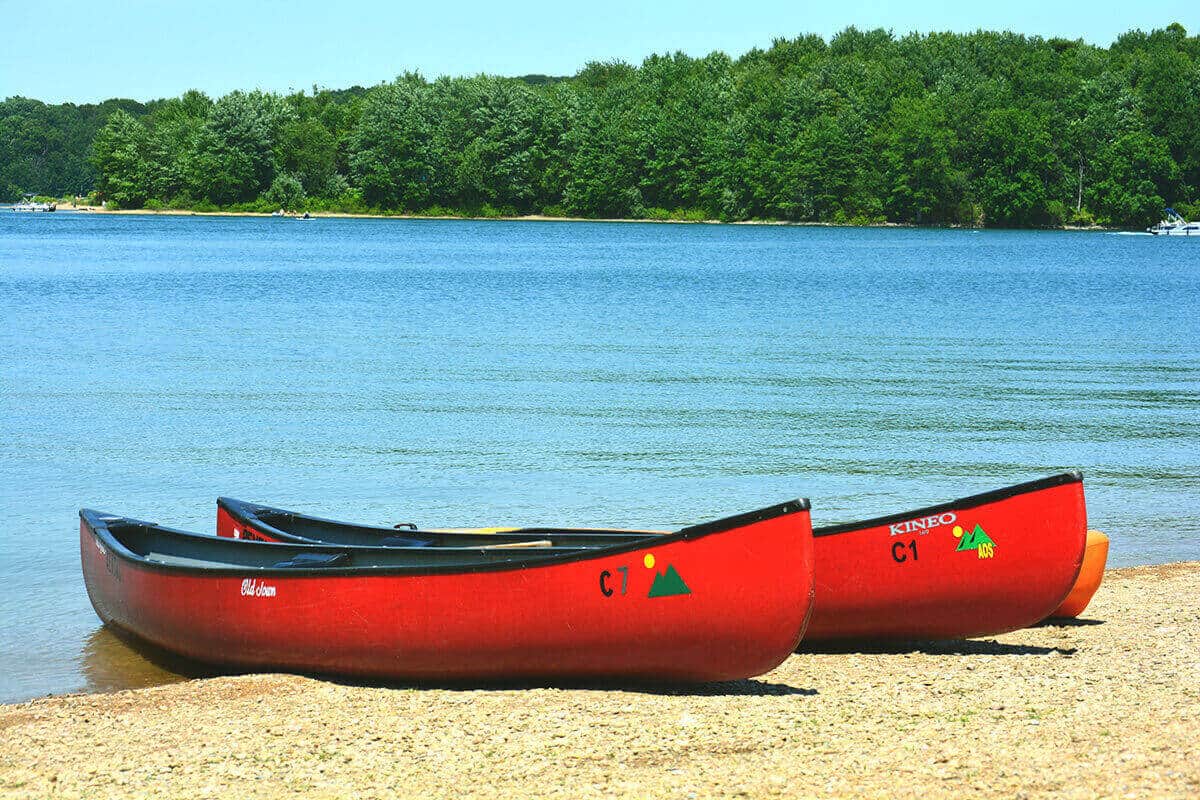
Cleaning Tips for Maintaining Your Boat: Properly cleaning your canoe or kayak is essential to its longevity. After each use, rinse off the boat with fresh water and let it dry completely before storing.
Stains from mud, bird droppings, oil, and other contaminants can be removed with 3M Marine Cleaner and Restorer.
You should also inspect the hull for any damage that may have occurred during your outing and repair as needed.
Additionally, you can apply a protective wax coating like 303 Marine Quick Wax to hard-shell models made of carbon fiber, fiberglass, and Kevlar to help protect against UV rays and saltwater corrosion while 303 Protectant can be used to protect polyethylene and inflatable hulls.
When not in use, store your canoe or kayak in a cool, dry place away from direct sunlight and extreme temperatures. If possible, hang it up on wall mounts or suspend it from the ceiling using straps so that air can circulate around the boat while keeping it out of harm’s way. For added protection against dust and dirt accumulation, put a boat cover on when not in use.
Conclusion
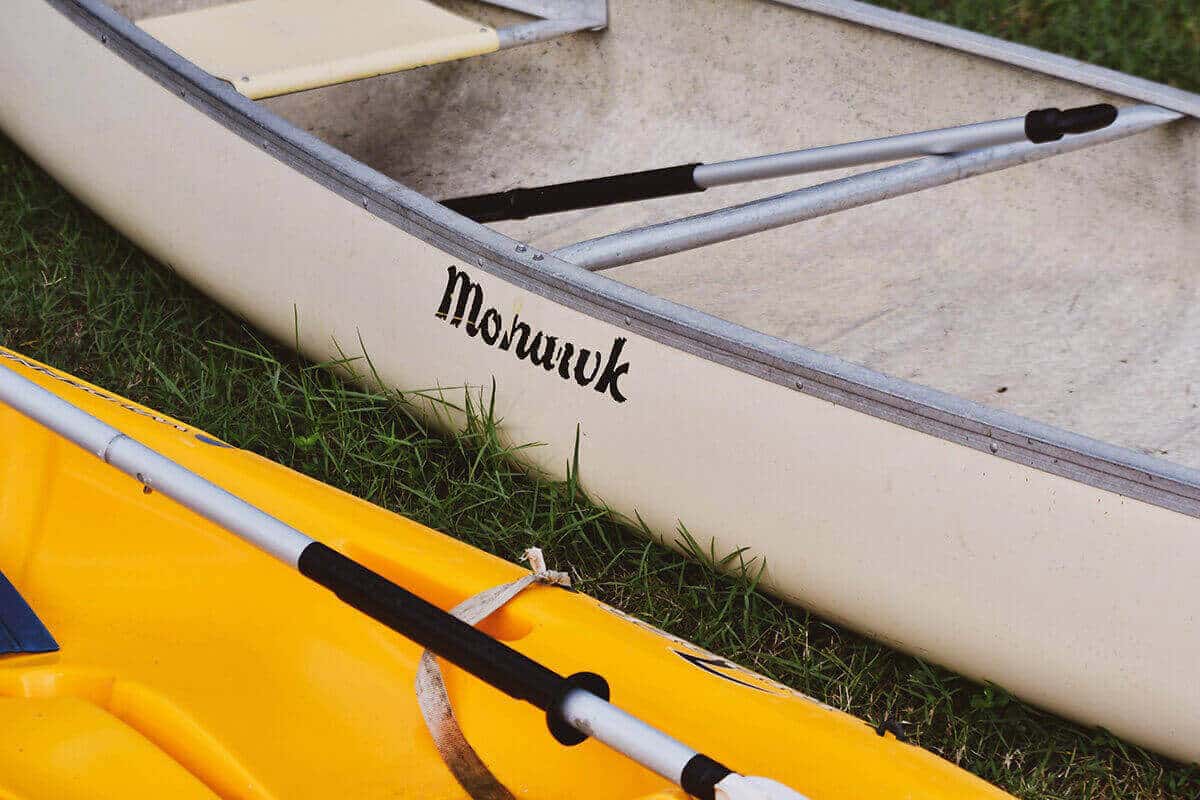
When it comes to deciding between a canoe and kayak, the best option for you depends on your individual needs. Consider the design differences, paddling differences, and performance differences of each before making your decision.
Canoes and kayaks each have their own advantages and disadvantages, as well as specific uses for different types of water. Ultimately, when it comes to the canoe vs kayak dilemma, only you can decide which is best for your outdoor adventures.
Safety considerations are important when using either type of vessel, so it’s essential to take the time to learn proper paddling techniques and safety procedures before getting out on the water.
Finally, regular maintenance can help keep your canoe or kayak in top condition for years to come. Whether you choose a canoe or a kayak, make sure you get out there and enjoy all that nature has to offer.
Are you interested in exploring the great outdoors? Are you looking to learn more about kayaking, canoeing, fishing, camping, and hiking? Then OtterBee Outdoors is for you!
We provide expert advice on all of these activities so that anyone can enjoy the beauty nature has to offer. From how-to tutorials to tips on selecting gear to in-depth hands-on product reviews – we have it all covered.
Join us today as we explore the best ways to get out there and experience what life has to offer beyond our everyday lives!
